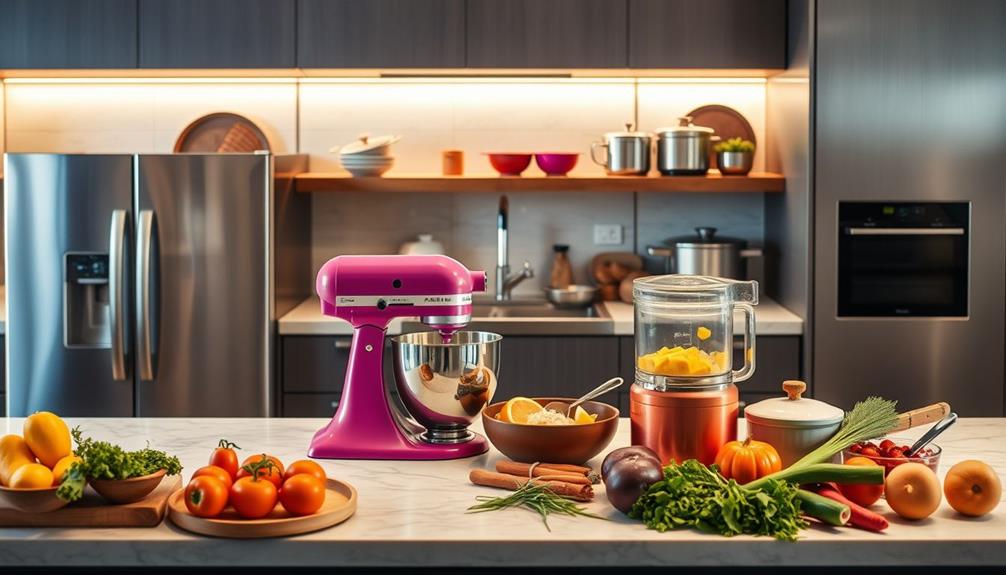For larger households, energy-efficient washing machines are crucial for saving time and money. Seek out ENERGY STAR certified models, such as the LG WM4000H or Electrolux ELFW7637A, which consume up to 45% less energy and 50% less water compared to traditional machines. These front-loaders typically offer a capacity of 5.0 to 6.0 cubic feet, enabling larger loads and reducing the frequency of laundry. Furthermore, smart technology adjusts settings for optimal efficiency. Consider pairing them with matching dryers for a superior laundry experience. By delving deeper, you will uncover which features are most important for your family’s specific needs.
Key Takeaways
- ENERGY STAR certified washers use significantly less energy and water, making them ideal for large families looking to save on utility bills.
- Large capacity models (5.0 to 6.0 cubic feet) accommodate substantial laundry loads, reducing the frequency of wash cycles.
- Advanced features like load sensing in high-efficiency models optimize water and energy use based on load size.
- Front-load washers, such as LG WM4000H and Electrolux ELFW7637A, offer superior stain removal and cleaning efficiency for busy households.
- Selecting compatible high-efficiency dryers can streamline the laundry process and enhance overall performance in large family settings.
Overview of Energy Efficiency
Energy efficiency is essential for large families, especially when it comes to washing machines. By choosing energy-efficient washing machines, you can greatly reduce your household utility bills.
These machines, particularly ENERGY STAR certified models, utilize up to 45% less energy and about 50% less water compared to traditional top-load agitators. This means you not only save money but also contribute to a more sustainable environment.
Additionally, using energy-efficient appliances can lead to overall improvements in your home's air quality, which is beneficial for family health, especially for those with allergies or respiratory issues, as seen with the importance of air purifiers.
When you opt for larger capacity washers, typically ranging from 5.0 to 6.0 cubic feet, you can accommodate larger loads. This feature helps reduce the frequency of laundry cycles, which further enhances energy efficiency.
Plus, many of these washing machines come equipped with smart technology that monitors and adjusts their performance based on load size, optimizing both energy and water savings.
Investing in an energy-efficient washing machine can lead to considerable savings—around $370 to $1,000 over its lifespan—thanks to reduced energy and water consumption.
For large families, these advantages make energy-efficient washing machines a smart choice that benefits both the environment and your wallet.
Top Front-Load Washers

When selecting a washing machine for a large family, front-load washers stand out for their impressive energy efficiency and capacity. Models like the LG WM4000H use 45% less energy and 50% less water compared to traditional top-load agitators, making them perfect for families with high laundry volumes.
Additionally, features like a self-cleaning brush roll in pet hair vacuums can greatly enhance cleaning efficiency, guaranteeing that households with pets can maintain a clean environment alongside efficient laundry practices. With a generous capacity of 5.2 cubic feet, you can tackle large loads in fewer cycles, saving time and resources.
Furthermore, the Electrolux ELFW7637A features SmartBoost technology that pre-mixes detergent with water, enhancing cleaning power and optimizing stain removal. This guarantees that even the toughest stains don't stand a chance.
Many front-load washers, including the GE GFW655, offer specialized cycles for bulky items like comforters, guaranteeing thorough cleaning without sacrificing energy efficiency.
Moreover, front-load washers are designed with a gentler washing action, preserving the quality of your fabrics and leading to longer-lasting garments. This not only boosts your laundry routine but also makes front-load washers a cost-effective investment for large families.
Choosing one of these models means you're prioritizing efficiency, performance, and the longevity of your clothes.
Best Matching Dryers

Finding the right dryer to pair with your energy-efficient washing machine is essential for maintaining a seamless laundry routine, especially for large families. You'll want the best matching dryer that complements your washer while being efficient and reliable. Here are two excellent options:
| Dryer Model | Price | Key Features |
|---|---|---|
| LG DLEX4000 | $798 | High efficiency, stackable design, smart features for large loads |
| Electrolux ELFE7637AT | $898 | Advanced fabric care technology, detergent dispenser, stackable design |
The LG DLEX4000 dryer is perfect for pairing with the LG WM4000H washer. It offers impressive energy usage and thorough drying performance for large loads. On the other hand, the Electrolux ELFE7637AT pairs well with the Electrolux ELFW7637A washer, featuring advanced fabric care technology that helps maintain your clothes' quality.
Both models provide stackable designs, which is a lifesaver for families with limited laundry space. Plus, the Electrolux's smart features enhance drying efficiency, making it an ideal choice for diverse fabric types. Choose wisely, and your laundry days will become a breeze!
Key Features to Consider

When choosing an energy-efficient washing machine for your large family, capacity and load size are essential factors.
You'll want a model with at least 5.0 cubic feet to handle those hefty laundry days. Additionally, pay attention to energy efficiency ratings; opting for Energy Star certified machines can save you money on utility bills while being kinder to the environment.
Consider incorporating stress management techniques to make laundry days less overwhelming and more efficient.
Regular maintenance of your washing machine can also enhance its performance and longevity, aiding in your household management.
Capacity and Load Size
How much laundry does your family generate each week? If you're like most large families, the answer is likely a lot.
That's where considering the capacity and load size of your washing machine becomes essential. Choosing a large capacity washer can transform your laundry routine, allowing you to tackle bigger loads and reduce the number of cycles you need to run each week.
Additionally, selecting a washing machine that's energy-efficient can lead to significant savings on utility bills, much like finding the right home cleaning service can enhance your cleaning routine.
Here are three key aspects to keep in mind:
- Capacity: Look for washers that range from 5.0 to 6.0 cubic feet. These models can handle up to 20 pounds of laundry, making them perfect for larger families.
- Bulky Items: Washers with a capacity of 5.5 cubic feet or greater can easily accommodate bulky items like comforters and towels, eliminating the hassle of multiple washes.
- Energy Efficiency: High-Efficiency Top Load Washers often consume less water and energy per load when fully utilized, which means fewer trips to the laundry room and lower utility bills.
Energy Efficiency Ratings
Choosing an energy-efficient washing machine not only enhances your laundry experience but also considerably reduces your household's environmental footprint. When you're evaluating machines, pay close attention to energy efficiency ratings. Look for ENERGY STAR certified models, which use at least 20% less energy and 40% less water than standard machines.
Opting for these eco-friendly appliances can be akin to choosing an island getaway for your laundry routine, offering both luxury and sustainability.
High-Efficiency Front Load Washers are often the best overall choice for large families. They typically use 45% less energy and 50% less water compared to traditional top-loaders, thanks to their advanced design and washing mechanisms.
These washers often come equipped with smart features, such as load sensing and optimized wash cycles, that help maximize cleaning performance while minimizing resource use.
Additionally, many energy-efficient models feature larger drum capacities, allowing you to wash more clothes per cycle. This reduces the total number of washes required, further conserving both energy and water.
It's also wise to contemplate machines with remote monitoring capabilities, enabling you to manage your energy consumption effectively by scheduling cycles during off-peak hours.
Performance and Reliability

When you're choosing a washing machine for your large family, performance and reliability are key factors to contemplate. You want a machine that not only cleans effectively but also stands the test of time.
Additionally, opting for models that are budget-friendly vacuum cleaners can help you manage your household expenses while maintaining high cleanliness standards.
Let's explore how cleaning efficiency metrics, stain removal effectiveness, and long-term durability insights can guide your decision.
Cleaning Efficiency Metrics
In today's fast-paced world, large families often face the challenge of keeping up with endless laundry while ensuring their cleaning appliances deliver efficiency and reliability.
When selecting an energy-efficient washing machine, you'll want to evaluate the following cleaning efficiency metrics:
1. Stain Removal Capabilities: Models like the LG WM4000H excel at tackling tough stains and can handle loads up to 20 pounds, making it a strong contender for large families.
Additionally, investing in quality accessories like headphone amplifiers can enhance your overall audio experience while you wait for your laundry to finish.
2. Wash Cycles Duration: While energy-efficient front-load washers may have longer wash cycles, such as the Electrolux ELFW7637A, they offer customizable settings that enhance cleaning performance.
3. Reliability and Performance: The GE GFW655 is known for effective mildew prevention and thorough cleaning, although it may also have extended wash cycles compared to some top-load washers.
Stain Removal Effectiveness
While many washing machines boast energy efficiency, their true value often lies in their stain removal effectiveness, especially for large families dealing with heavily soiled laundry. You need a washer that not only saves energy but also delivers powerful cleaning to tackle tough stains.
Here's a quick comparison of some top options:
| Washing Machine Model | Stain Removal Features |
|---|---|
| LG WM4000H | Multiple wash cycles for various fabrics |
| Electrolux ELFW7637A | SmartBoost technology for enhanced cleaning |
| Maytag Pet Pro MVW6500MBK | Designed for pet hair and tough stains |
| GE GFW655 | Mildew prevention with thorough cleaning |
| LG Signature WM95000HKA | TurboWash technology for stubborn stains |
Models like the LG Signature WM95000HKA utilize TurboWash technology, making it easier to tackle even the most stubborn stains. The Electrolux ELFW7637A stands out with its SmartBoost feature, ensuring superior stain removal performance. If you're a pet owner, the Maytag Pet Pro MVW6500MBK is specifically designed to capture pet hair and handle tough stains. With these energy-efficient washing machines, you'll find the perfect balance between efficiency and stain removal reliability.
Long-Term Durability Insights
Choosing an energy-efficient washing machine goes beyond just stain removal; long-term durability and performance are equally important, especially for large families who rely on their washers for heavy loads.
Models like the LG WM4000H and Electrolux ELFW7637A are designed for longevity, often outperforming competitors in reliability. Additionally, selecting a machine that aligns with your lifestyle, such as those that can handle larger loads, is crucial for efficiency.
Here are key insights for guaranteeing durability:
1. Front-Loading Models: They typically offer a longer lifespan due to their gentler washing mechanisms. This reduces fabric wear and tear, keeping your clothes in better shape over time.
Furthermore, regular exposure to high-quality detergents can enhance the washing process, much like how proper nutrition impacts dog health.
2. Regular Maintenance: Simple upkeep, such as cleaning the drum and using high-efficiency detergents, can considerably extend the operational life of energy-efficient washers. Many can last 10-15 years with proper care.
3. Brand Reputation: Choosing reputable brands matters. While models like the GE GFW655 are effective, they may experience reliability issues over time, emphasizing the importance of selecting a durable option based on solid consumer feedback.
Investing in a reliable, energy-efficient washing machine guarantees your family's laundry needs are met efficiently and sustainably.
Maintenance and Care Tips

Maintaining your energy-efficient washing machine is vital for keeping it running smoothly, especially in a busy household. Start by running a maintenance wash once a month with hot water and a washing machine cleaner. This helps remove residue and keeps your appliance in prime condition, particularly after washing heavily soiled items.
Additionally, using the right garage door openers can enhance overall home security and provide peace of mind while managing household chores.
To prevent mildew and odors, regularly clean the washer drum and door seals using vinegar or bleach. This is important for high-capacity models that see frequent use.
Additionally, always use the appropriate high-efficiency (HE) detergent to maintain performance. This not only prevents excess suds that can damage your machine but also guarantees peak cleaning.
When doing laundry, pay attention to loading techniques. Avoid overloading the washer, as this can disrupt balance and efficiency during cycles, leading to wear and tear.
Don't forget to check and clean the lint trap in your dryer after every use. This guarantees peak drying efficiency and prevents overheating, especially when handling larger loads.
Capacity Options for Families

When you're part of a large family, selecting the right washing machine capacity can considerably streamline your laundry routine. With capacity options ranging from 0 to 6.0 cubic feet, you can choose a model that fits your needs perfectly.
Think about exploring healthy lifestyle blogs for tips on managing household chores effectively, as this can free up time for family activities.
Here are three key points to reflect on:
- Optimal Capacity: Aim for washers between 5.0 to 6.0 cubic feet. These sizes handle bigger loads, reducing the number of cycles needed and improving cleaning efficiency.
- Bulky Item Accommodation: If you frequently wash bulky items like comforters and towels, look for models with a capacity of 5.2 to 5.8 cubic feet. This space guarantees you get thorough washes without compromising on performance.
- Energy and Water Savings: Choosing a washer in the 5.0 to 6.0 cubic feet range not only enhances your washing efficiency but also leads to significant water and energy savings. For instance, a 5.5 cubic foot washer can accommodate about 20 pounds of laundry, making it ideal for heavy-duty needs.
Investing in the right capacity option can make laundry days quicker and more efficient for large families like yours.
Future Trends in Washing Machines

As washing machines evolve, you can expect exciting advancements that prioritize energy efficiency and sustainability. In 2025, new models are set to reduce water usage by up to 50% compared to traditional top-loaders, making laundry day more eco-friendly.
You'll find that smart technology integration will allow you to control and monitor your washing cycles remotely, optimizing wash times to save energy and lower your utility costs.
The trend towards eco-friendly appliances is on the rise, with manufacturers exploring biodegradable materials and designs that minimize microfiber shedding—crucial for protecting our environment.
Additionally, compact designs are becoming increasingly popular, catering to urban families with limited space while still offering high-capacity options.
Energy Star certification will remain an essential feature for new washing machines, ensuring you're investing in models that save you an estimated $500 or more over their lifespan.
These innovations not only enhance your laundry experience but also contribute to a more sustainable future. Keep an eye out for these trends to find the perfect energy-efficient washing machine that meets your family's needs!
Frequently Asked Questions
Which Washing Machine Is Best for Large Family?
When choosing the best washing machine for your large family, consider capacity, efficiency, and features. Look for models with at least 5.0 cu. ft., customizable settings, and energy certifications to streamline your laundry routine effectively.
What Size Washer Is Best for a Large Family?
When it comes to washing machines, think of a spacious ocean. A washer between 5.0 to 6.0 cubic feet is your best bet, easily tackling hefty loads while conserving water and energy. You'll sail through laundry days!
What Type of Washing Machine Is Most Energy Efficient?
If you're looking for energy efficiency, front load washing machines are your best bet. They use considerably less water and energy, saving you money over time, especially when you choose ENERGY STAR certified models.
What Is the Highest Energy Rating for Washing Machines?
The highest energy rating for washing machines is ENERGY STAR. When you choose an ENERGY STAR certified model, you're selecting a washer that exceeds federal efficiency standards, ensuring both performance and savings on your energy bills.
Conclusion
In the quest for the ultimate energy-efficient washing machine, you're not just choosing an appliance; you're igniting a laundry revolution! Imagine this: your colossal family's dirty clothes disappearing like magic, while saving the planet one wash at a time. With high-quality features, unmatched performance, and jaw-dropping capacity, these machines are practically superheroes in disguise. So, gear up and plunge into the world of efficiency—your laundry room is about to become the envy of every household!









